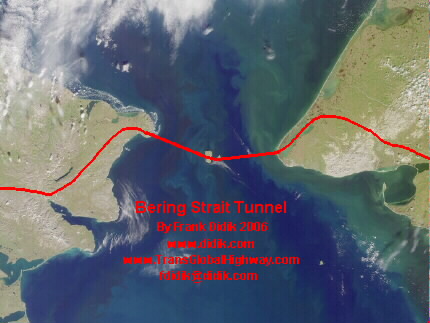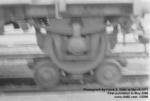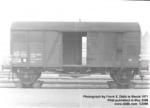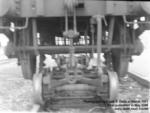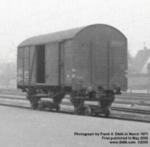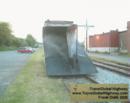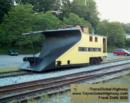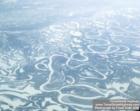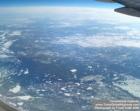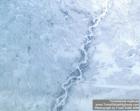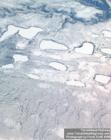|
|
TransGlobalHighway.com
www.didik.com
Proposal for a
Trans Global Highway
Peace and
prosperity for all through mutually beneficial trade
By Frank Didik
2024
"I would
like to go from New York City to London. By car. Before the end of my
life, I would like to drive from New York City to Alaska and go
through the AmerAsian Peace Tunnel across the Bering Strait,
connecting the United States with Russia. From there, I plan to drive
south along the trans Siberia highway and cross under the bay from
Siberia to the Sakhalin Island (Russia), which is known for its
natural beauty and enormous mineral and gas reserves. From Sakhalin,
I will drive to Japan, via the Sakhalin-Hokkaido Friendship Tunnel
and then to the main Japanese island of Honshu through the 33.5 mile
/ 50km long Seikan ocean tunnel (built in 1988), and on to Tokyo.
From there I plan to go to southern Honshu and cross over the
(existing) bridge to the southern Japanese island of Kyushu and from
there, through the Korean-Japan Friendship Tunnel. Going through the
open borders of the Korea's, I plan to than drive through China,
India, Pakistan, Afghanistan, Iran, Iraq, Syria, Israel, Egypt and
all of north Africa to Morocco, where I plan to drive through the
EurAfrican Friendship Tunnel, ending in the southern tip of Spain,
just south of Gibraltar. From there, I plan drive north
to France and finally to England, via the 31.3 mile long
"Chunnel", which has a special train to carry automobiles
under the English Channel. I want to do this, in complete safety, through limited
or open borders".
I
admit that in today's world, what I have just described seems utterly
inconceivable; perhaps the unattainable dream of an idealist. On the
other hand, consider that in 1939, the thought of a completely open
Europe, without borders, would also have seemed totally impossible.
In August, 1989, who would have dreamed that in just one month, the
borders between "east" and "west" Germany would
be gone forever? Yet what seemed impossible is reality today. The
Trans Global Highway can and will eventually be constructed, in one
form or the other. Frank X. Didik, New York City, May, 2006
Click
on any photograph to enlarge. Use your back key to return to this menu.
|
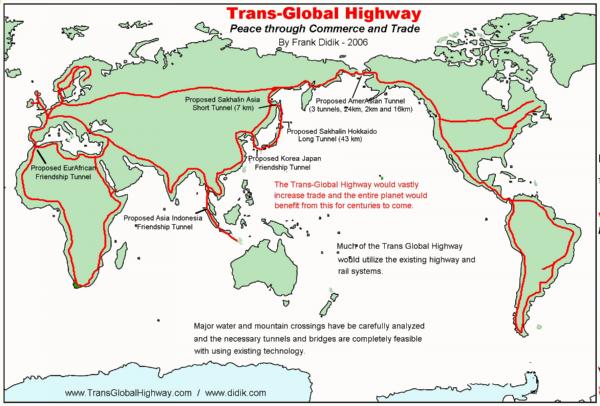
The
road outlines are tentative and are designed to utilize the existing
highway grid. Thus many more arteries than illustrated above, would
be connected to the backbone of the Trans Global Highway. Not clearly
shown in the map above is that North America and Asia are to be
connected by the Bering Strait Tunnel
The Trans Global Highway would physically link by highways and
by rail transport, all continents and major population centers, with
the present exception of Australia, which, in the future, may be
linked via very long suspended, pre-formed, suspended underwater
tunnels from extending from the Philippine island chain.
From a human point of view, the advantages of the Trans Global
Highway are enormous. First, it would allow rapid transport of raw
materials and finished goods from near and far. In addition, the
Trans Global Highway would offer a conduit for gas, oil and water
pipelines, as well as communication and electric power cables. It
should be noted that fresh water is a major issue among arid areas,
throughout the world, including the Middle East, western United
States, Africa and Central Asia. The Trans Global Highway combined
with water pipelines from areas of abundance to arid areas, could
benefit humankind even more. Perhaps there is a solution to the
theoretical threat of global flooding from melting land ice at the
poles, that some people fear.
The Trans Global Highway would undoubtedly increase global
security through mutually dependent trade and commerce. As with
almost all major public works projects, such as the Suez Canal, the
Panama Canal, the Chunnel, the Alaska Pipeline and others, many
people will argue that the tunnels, bridges and roads are not
necessary. Some may present counter arguments stating that existing
air and sea transport is just fine. Further, the cost may at first,
may seem astronomical, but in retrospect, every one of these
visionary projects has greatly helped mankind in commerce and
progress. Ultimately, the Trans Global Highway will be constructed,
in one form or the other, but we have an opportunity to start with,
at least the ground work of planning, today. The primary obstacles,
are not technical, and not even financial, even though the costs may
seem high. The real obstacle to the construction of the Trans-Global
Highway is political. Many bordering countries are presently at odds
with one another, and may not be willing to allow a free moving
highway to run through their territories, even with the potential of
vast economic benefits.
From a technical point of view, the entire road and rail
network is feasible, utilizing the engineering, materials and
technology of today. At first glance, the development obstacles of
the AmerAsian Peach Tunnel (Bering Strait
tunnel) may seem insurmountable, but this is not the case.
The Bering Strait Tunnel would consist of 3 tunnels
connecting Alaska and Russia by going through two islands (the Little
Diomede(USA) and Big Diomede (Russia)). The longest single tunnel
would be 24 miles in length. Since the Bering Sea at the
proposed crossing has a maximum known depth of only
170 feet, it is proposed that the tunnel be dug using conventional,
modern tunnel boring machines, of the type that was employed in the
construction of the Chunnel. The three tunnel proposal would be much
preferred over a bridge for a variety of reasons including that fact
that during the winter months, the Bering Strait is iced over and a
bridge would be subject to sever environmental conditions. Further,
in most cases, tunnels are both less expensive to construct and cost
less to maintain. Suspended under water tunnels are not suggested for
this crossing, because of the shallow depth of the Bering Strait.
It is proposed that the AmerAsian Peace Tunnel start on the US
side, from the town of Cape Prince of Wales, which has a population
of 156 and about 80 buildings, including a large school, streets and
general store, and end at the Russian settlement of Naukan or 2 km
north at the Dezhnev settlement. It is further proposed that the
tunnel pass though both Little and Big Diomede islands which can be
used for ventilation shafts and possibly as a relief station. Both
Little Diomede (USA) and Big Diomede (Russia) have been occupied for
hundreds of years. Little Diomede has a Inalik native village with a
population of about 200 and has a high school, store, Post Office, a
community hall and many residences. The terrain of Cape Prince of
Wales is very similar to the rolling grassy hills of Scotland and the
gentle hill ends at a flat area at the Bering Strait with a very nice
beach. The terrain of the Diomedes as well as the Russian Asiatic
mainland is similar to the fiords of Norway, though the tops of the
hills again are very similar to the rolling grassy hills of Scotland.
Archeological findings, date back to over two thousand years. There
are relatively flat areas along the coast of Russia, around the
proposed exit of the tunnel, that would be ideally suited for a major
highway and rail transport. In the winter time, the surface of the
Bering Strait is frozen and it is possible to walk or even drive
across the Strait, however, this is very dangerous, not to mention
that crossing would be going across international borders. The tunnel
would not be affected by the frozen Strait and tunnels under similar
conditions have been constructed world wide.
|
State
of Alaska Photo
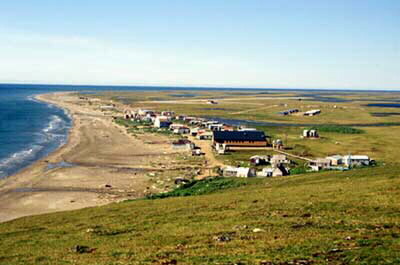
Cape
Prince Wales (USA), looking towards Russia, in the summertime. |
USGS
Photo
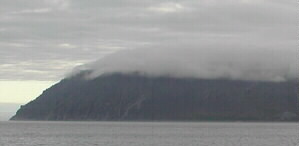
Big
Diomede (Russia) |
|
USGS
Photo

Asiatic
Russia, just past the Diomede, in summer. The green is enhanced. In
reality, the greenery is similar to Cape Prince of Wales, Alaska. |
USGS
Photo

Little
Diomede (USA) in the foreground. |
It should be noted that presently, there are many tunnels
around the world that are as long as the longest tunnel needed to
complete the Trans-Global Highway. The "Chunnel" linking
England with Europe is approximately 31.34 miles (50.45km) long, the
ocean tunnel Seikan linking Hokkaido with Honshu in Japan is 33.46
miles (55.86km) long, while the new Swiss Gotthard tunnel through the
Alps, currently under construction, will be 35.7 miles (59.60km)
long. There are in fact, 5 tunnels over 30 miles in length, in
existence today.
Path of the
proposed AmerAsian / Bering Strait Tunnel
Click
on any photograph to enlarge. Use your back key to return to this menu.
(Please
also view the more detailed maps, found on the column to the right)
|
The
Bering Strait is named after Captain Vitus Bering of the Imperial
Russian Navy, who was sent by Peter the Great, in 1725, to explore
the ocean surrounding the eastern most reaches of Russia. |
Japan could technically be connected with mainland Asia via
five tunnels extending from the city of Fukuoka on Kyushu to the port
city of Pusan in Korea via four islands. The maximum ocean depth in
this area is 480 feet. It is also feasible to connect Japan to
mainland Asia by constructing two tunnels extending north from
Hokkaido to Sakhalin Island, which would be 25 miles (42km) long and
a second tunnel from Sakhalin to the Siberian Russian mainland, which
would only be 4.2 miles (7km) long. Recent estimates are that as much
as 20 million tons of goods, manufactured in Japan could be shipped
overland via the Russian railroad system, bypassing the current
costly shipping costs, that include transit through the Suez Canal.
There is a major financial incentive to build the Hokkaido Sakhalin-Siberian
tunnel. It should be noted that the Russian standard gauge railroad
tracks have a slightly higher gauge than the global standard. Thus
the rails on the Russian guage tracks are approximately 8"
(20cm) farther apart than the rest of the standard gauge rails. This
system was adapted to have a wider footprint, to minimize sinking in
the soft summer soil in the tundra region (though some historians
have also stated that this "non-standard" was adapted to
prevent foreign armies from quickly using Russian tracks in the event
of war. Prior to the 1905 Russo-Japan war, the Chinese railroads,
which Russia built, also used this wider gauge After 1905, when the
Japanese took over the Chinese rails, the Japanese rebuilt the rails
to conform with the global standard, which Japan had adapted. Today,
railroads employ various techniques to overcome this inconsistency
including the addition of undercarriage hubs. One example of how
conflicting gauges are dealt with is shown below in the photographs
shot by the author in 1971. Perhaps a better, automated solution
would be to use flat cars designed to use the global standard 40 foot
(12 meters) and 20 foot (6 meter) shipping containers. These
containers could be loaded from one gauge flat car to another gauge
flat car in a matter of seconds. The author was amazed by the speed
in which container ships were loaded and unloaded. Similar special
technology can be engineered to do the same with railroads. The
Sakhalin Island has an advanced and extensive rail system. Further,
the Sakhalin Island region is very wealthy, being one of the major
oil producing regions of the world.
|
Example
of how the Russian gauge railroad cars
can
be made to run on European gauge track.
These
photographs were shot by the author in 1971 when he was just a child,
while
traveling in Wiebligen, western Germany, interested in model
electric trains.
Click
on any photograph to enlarge. Use your back key to return to this menu.
Click
to enlarge. Use your back key to return to this menu. |
|
Dealing
with the snow
Much
of the arctic region has limited snowfall and can be controlled and
handled through conventional rail and road snow removal techniques.
In certain areas of high snow fall and accumulation, it may be
possible to construct steep roofed, prefabricated, inexpensive snow
roofs along the length of the effected track or road.
|
This is an old fashioned train
snow plow found in Honesdale Pennsylvania. |
Unlike this 100 year old train,
modern railroad snow removal trains employ snow blowers that run at
relatively high speeds. |
|
The
photographs below illustrate the terrain of norther Alaska and
Canada,
where photographed by the author, while flying in a commercial
Airline from New York City to Japan, in February, 2003. This
seemingly harsh terrain in fact is crisscrossed by roads and even
small airports. The terrain in Alaska and Russia, around the Bering
Strait is slightly less rugged. Existing paved roads exist in both
Russia and Alaska within a few miles of the Strait. These roads can
be widened to form part of the Trans Global Highway. In the
summertime, much of this area is spectacularly green with tall grass.
It may be possible to encapsulate the expanded and enlarged roads and
rail links with a network of in-expensive overhead prefabricated protectors.
Click
on any photograph to enlarge. Use your back key to return to this menu.
|
|
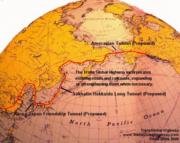 |
GLOBAL
WARMING
A
possible solution for Global Warming Issues and concerns. |
Recently,
there has been concern in the media that the earth is getting warmer
and this has been referred this as "global warming". Some
people have gone so far as to state that the Arctic and Antarctic ice
caps are melting and that the coastal areas will be under water in
the near future. Weather or not these dire predictions are correct,
the fact is that the Trans-Global Highway could act as a pathway not
only for rail roads and vehicular traffic, but also for oil, gas and
water pipe lines. Fresh water could be piped from the fresh water
rich northern regions to the arid parts of the world. Overnight,
issues regarding water usage could be solved. Presently, there are a
number of areas in need of additional fresh water including the
western states of the United States, the Middle East, central Africa
and Central Asia. The Trans Global Highway, with fresh water
pipelines running beside it, would be able to relieve the need for
rationing water.
In regard
to "Global Warming", it should be noted that historically,
earth does seem to go through long warm-cool cycles. For example,
1100 years ago, southern Greenland still had trees, but these died
out as Greenland became progressively colder between 900 and 1100AD.
Today, it seems that we are indeed entering into a warmer period. It
should also be noted that ice melting on water does not increase the
height of the water, since it has already displaced this water. If
ice is on the land and melts, it is possible that resulting water
could theoretically flow into the oceans and perhaps raise the sea
level by a modest amount. |
 Download PDF Version
Download PDF Version |
|
|
|
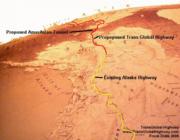
The proposed
AmerAsian Tunnel would link North America and Asia, across the Bering
Strait, for the first time in an estimated 9 thousand years. It would
create a highway, railroad, fresh water, oil and gas pipelines and
communication crossings. |
|
|
|
|
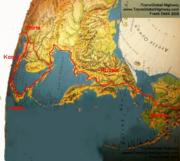
The construction
and use of the AmerAsian Tunnel would greatly reduce the overall cost
of transporting finished goods and raw materials to and from Europe,
Asia, North and South America. |
|
|
|
|
|
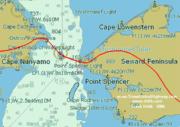
From and
engineering perspective, the construction of the AmerAsian Tunnel is
straight forward without any particularly complex issues involved.
The Tunnel would comprise of 3 tunnels connecting Alaska and Russia
going through the Little and Big Diomede Islands.
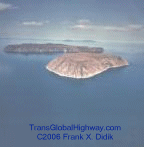
Little and Big
Diomede Islands showing path of proposed Bering Strait tunnels. |
|
|
|
|
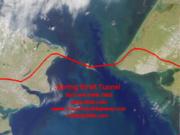
The Bering Strait
is very shallow with a maximum depth at the proposed tunnel crossing
of only 170 feet (52meters). The surface of the Bering Strait is
frozen some of the time. The tunnel could be constructed in segments
in factories and then sunk and assembled underwater. It could also be
construced using modern tunnel boring machines or TBM's.
 |
|
|
|
|
|

The TransGlobal
Highway would incorporate the existing railroads and highway networks
in each country. The illustrated path of the proposed TransGlobal
Highway would also have numerous other tributary roads. |
|
|
|
|
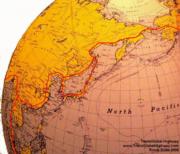
Existing roads may
have to be strengthened and or widened and brought up to a single
standard. The railroads of Russia are of a slightly wider gauge This
was designed to provide a greater footprint so that the rails would
not sink in the soft soil. Technologies exist for dual gauge train
cars. (Kindly see photographs of dual gauge trains, below). |
|
|
|
|
|
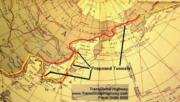
The world as a
whole, would greatly greatly benefit from the TransGlobal Highway.
For example, Japan, in 2002, shipped 12 million metric tons of
finished goods to Europe, primarily by ocean. Some of the goods went
through the Suez Canal, while a portion of the goods also went around
South Africa. The shipping time from Yokohama to the European port of
Antwerp was in the order of 45 days. By rail, via the Trans Global
Highway, this time could be reduced to 12 days. |
|
|
|
|
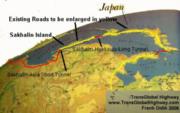
It is proposed
that two major tunnels be constructed to link Japan with Asia. These
being the Korea-Japan Friendship Tunnel and the Hokkaido to Sakhalin
Island-Asia Tunnel. These tunnels would thus quickly connect Japan
and the rest of the world to quickly and effectively transport people
and goods, at a minimal cost.
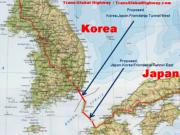 |
|
|
|
|
|
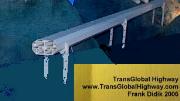
None of the major
tunnels that would have to be constructed for the TransGlobal Highway
would be particularly difficult to build. All of the tunnels would be
going through relatively shallow water. The tunnels can be
constructed in segments and than sunk and anchored to the bottom.
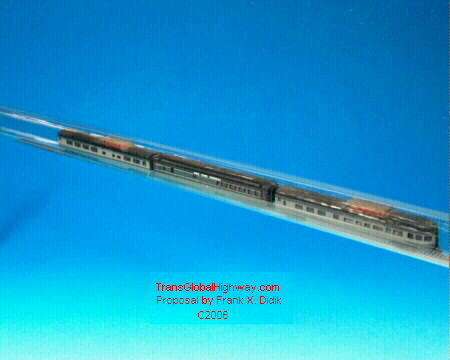 |
|
|
|
|

In some
cases, could in fact be suspended from the ocean floor, deep enough
not to be effected by adverse surface weather conditions. This system
is not envisioned nor needed for the proposed tunnels, however this
system could be employed if at such time, a tunnel was to be
constructed to link Australia to the rest of the world, between the
Cape of York Peninsula in Australia and Papua New Guinea or Darwin to
Timor, via Melville Island. (See below for more details). |
|
|
|
|
|
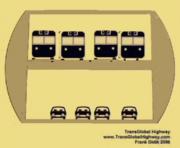
The proposed
segmented, prefabricated tunnels could provide for both vehicle as
well as rail transport, though with the potential complexity of
ventilation, a Chunnel approach may have to be taken, whereby the
vehicles are transported by electric powered railroad, through the
tunnel. Equally important, the Trans Global Highway would offer a
pathway for oil and gas pipelines, communication cables as well as
water pipelines to transport fresh water from areas of abundance to
arid areas. |
|
|
|
|
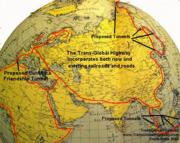
In a way, much of
the TransGlobal Highway already exists in local roads and highways
across the globe. The proposed TransGlobal highway would utilize the
existing transportation network, extending, widening and perhaps
strengthening it so that it forms a uniform global highway. |
|
|
The
Trans-Global Highway would include:
1.
Road transport
2.
Robotic Railroads
3.
Oil and gas pipelines
4.
Electric and communication cables
5.
Fresh water pipelines could minimize the concern of flooding as
presented in the theory of global warming. |
|
|
|
|
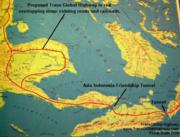
A series of long,
though not particularly difficult to construct tunnels is proposed to
be built linking Indonesia and Australia with the rest of Asia,
Europe and the world. This would be a huge advantage for global trade
and travel. It should be noted that in every case when a major bridge
or tunnel has been proposed, there are groups of people who have
argued that existing ferries and boats or out of the way roads were
good enough. The fact is that after such construction, everyone
immediately agreed that the bridge or tunnel was needed. Such
examples can be seen with the Chunnel, the Brooklyn Bridge, the
Varazono Narrows bridge and many other examples. |
|
|
|
|

If a tunnel
was to be constructed to link Australia to the rest of the world,
between the Cape of York Peninsula in Australia and Papua New Guinea
(147km / 88.2 miles) or Darwin to Timor, via Melville Island (400km /
240miles). These incredibly long tunnels are not being proposed at
the present time, though it should be noted that the Swiss Gotthard
tunnel through the Alps, which is at the final stages of completion,
will be 35.7 miles / 59.60km long. Arguable, the Swiss tunnel, bored
through solid rock, is more difficult to construct than the potential
Australia-Papua New Guinea tunnel. Presently, a major seaport is
proposed to be constructed on Timor so to link Timor with Darwin and
the rest or Australia. |
|
|
|
|
|
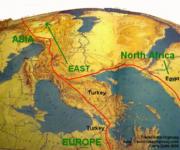
Turkey, which is
situated both in Asia and Europe, is presently linked to Europe via
two bridges. A third bridge is Presently at the beginning phases of construction. |
|
|
|
|
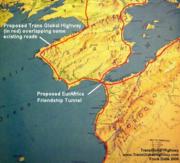
The concept of
linking Spain with Africa, in the area of Gibraltar has been dreamed
of and proposed, many times over the past thousand years. The
proposed EurAfrica Tunnel is an absolute must and is technically very
easy to accomplish. It would allow a vast amount of raw materials and
finished products to be sent back and forth between Europe, Africa
and the middle East. |
|
|
|
|
|
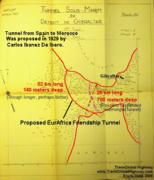
This illustration
is based on the 1929 proposal to link Spain with Africa, just south
of Gibraltar. With some slight modifications, and a much wider
(though not longer) tunnel, Europe and Africa can finally benefit
quickly and easily from one another. |
|
|
Click
on any photograph to enlarge. Use your back key to return to this menu.
Closeups
of Key Proposed Tunnels
Please
click map to enlarge.
|
|
|

Closeup of the
proposed path of the AmerAsian Friendship Tunnel. |
|
|
|
|
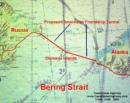
The AmerAsian
Friendship Tunnel would consist of 3 tunnels, with the longest being
23 km. The tunnel could be built in 10 years at an estimated cost of
5.5 Billion (thousand million) U.S. Dollars. |
|
|
|
|
|

Closeup of the
proposed path of the Sakhalin-Hokkaido Long Tunnel. |
|
|
|
|
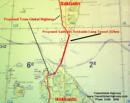
The
Sakhalin-Hokkaido Long Tunnel would be 42km long and could be
constructed in 9 years, at the cost of approximately 4.2 Billion
(thousand million) U.S. Dollars |
|
|
|
|
|
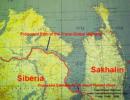
Closeup of the Sakhalin-Asia
Short tunnel that would connect the Sakhalin Island with Siberia. |
|
|
|
|

The proposed Sakhalin-Asia
Short tunnel would be 7km (4.2 miles) long. It could be constructed
in 4 years at an estimated cost of 350 million U.S. Dollars. |
|
|
|
|
|

Expanded view of
the region surrounding the The proposed Sakhalin-Asia Short tunnel |
|
|

Proposed path of
the Sakhalin-Hokkaido Long Tunnel and the existing Seikan ocean
tunnel . |
|
What about
Plate Tectonics?
Plate
tectonics, should not play any significant role in the design.
Nevertheless, in certain cases, such as the AmerAsian Peace Tunnel
across the Bering Strait, a careful engineering study should be made
to determine, what, if any effect, would the theory of plate
tectonics have upon the proposed tunnels. Today we have many
engineering marvels which defy the powers of nature including massive
dams, flood water levies and incredible structures, such as Taipei
101, which is presently the worlds tallest building and is built in a
major earthquake zone. The slight but predictable changes in plate
orientation can be taken taken into consider during the design phase. |
TRANS-GLOBAL
HIGHWAY REPORT ON CD-ROM: A complete, highly detailed report, is
available on cd-rom that covers the entire proposed route and
proposed solutions to all issues regarding the technical issues
regarding the Trans-Global Highway. If you represent a government
agency, think tank, academic institution, bank, environmental group
or major corporation, kindly send an email explaining your interest
in this project.
TRANS-GLOBAL
HIGHWAY documentary designed for television, is being produced
and will be available shortly. |
The
Trans-Global Highway
Peace and
prosperity through commerce
www.TransGlobalHighway.com
www.DIDIK.com
 
(New
York, NY USA)
Comments?
Send an email to: inquiry
[at] didik.com
To
control spam, please write "Trans Global Highway"
in
the heading section of your email
By Frank X. Didik ©2006
|
|
|
2024 update
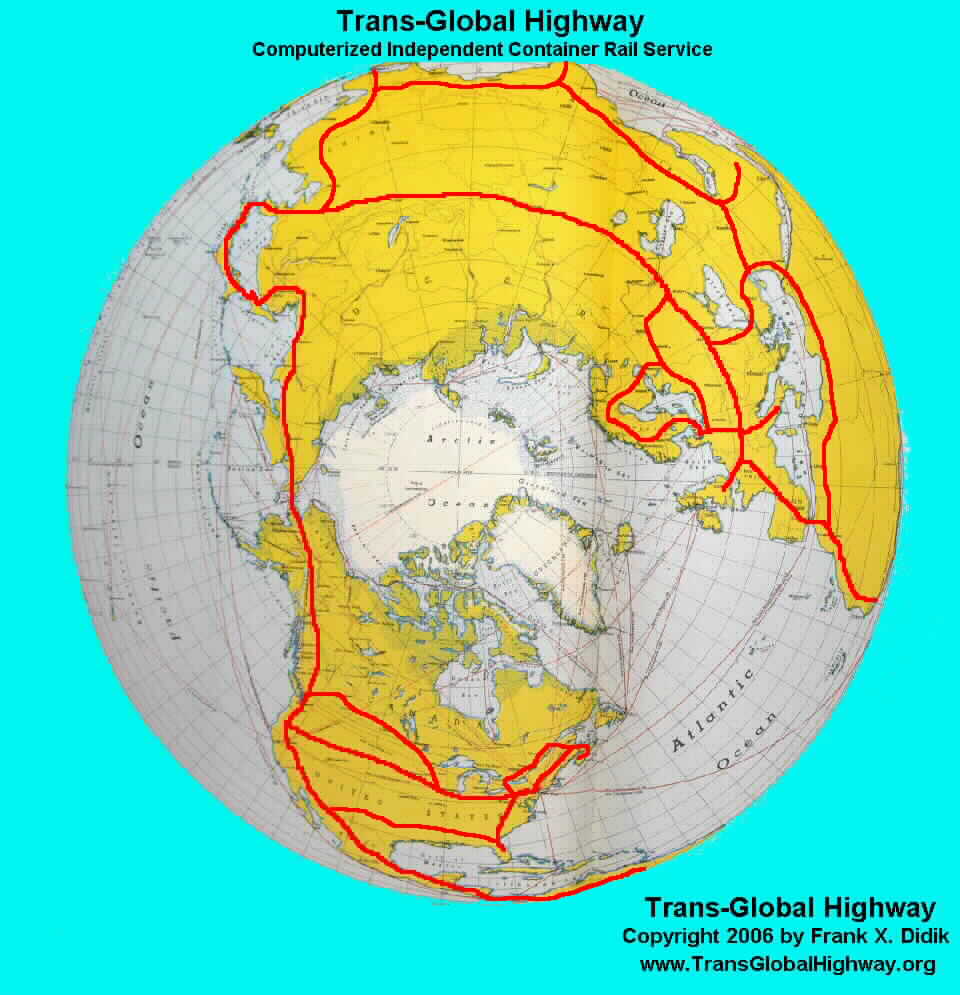
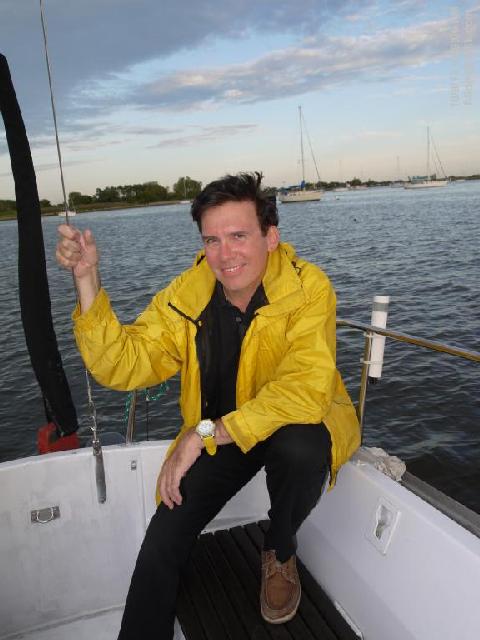
Frank X. Didik aboard his sailboat
"The Futurist", anchored
in New York Harbor.
Please
share this project on
and
Since 2006, when my Trans Global Highway proposal created shock
waves, there have been several changes in technology, the political
environment as well as new global concerns, particularly in the area
of the environment. Rather than updating my original proposal to the
left, which has become a sort of internet standard, this column will
attempt to address some of the changes that have occurred over the
past 20 years.
The
Trans Global Highway is even more important today, than it was when
I first considered the Trans Global Highway in the late 1970's or
when I wrote the internet proposal in 2006. The construction of the
Trans Global Highway would greatly increase the overall global
standard of living and would alleviate certain fears regarding over
population and limited resources. The Trans Global Highway will be
able to quickly distribute the resources from one part of the world,
to another.
Over
the past 20 years, I have traveled around the world to many places
and have repeatedly flown over vast tracks of uninhabited areas of
Asia and North America. It is clear that the Trans Global Highway
will allow huge areas of resources to become accessible and this will
have the effect of vastly improving the lives of so many people and
as a consequence, will open up vast new areas of business that will
result in overall global progress.
The fact is that the Trans Global Highway will revolutionize the
world. Whole new industries would develop as a result of the Trans
Global Highway. Products that in the past were too expensive to
transport great distances, could suddenly have new markets opening
up. Heavy farm equipment could be transported from one area to
another, depending on the planting season. Water and natural
resources, that in the past were too far or isolated from urban
areas, can suddenly be transported around the world. Electrical power
plants could be situated in remote areas of the world, far away from
large urban cities and the concerns that some people may have about
them. the advantages to human kind is endless and will benefit the
world for centuries to come.
Why
Build the Trans Global Highway?
One
excellent solution to future population concerns as well as
alleviating many of the effects of potential global warming is the
proposal for the construction of the Trans Global Highway. The
proposed Trans Global Highway would create a world wide network of
standardized roads, railroads, water pipe lines, oil and gas
pipelines, electrical and communication cables. The result of this
remarkable, far sighted project will be global unity through far
better distribution of resources, including heretofore difficult to
obtain or unaccessible raw materials, fresh water, finished products
and lower global transportation costs.
With greatly expanded global fresh water distribution, arid lands
could be cultivated resulting in a huge abundance of global food
supplies. The most conservative estimate is that with the
construction of the Trans Global Highway, the planet will be able to
feed several billion more people, using presently available modern
farming technologies. With the present global population of just
under 7 billion people and at the United Nations projection of
population increase, the world will produce enough food surpluses to
feed the expected increased population for several hundred years.
Technical
Feasibility
All aspects of the technology needed to build the Trans Global
Highway is fully understood and has already been developed and thus
the can be built right now, with the technology of today. Further,
the Trans Global Highway for sure is economically viable and in fact,
would recolonize business and all social aspects of society. The
major reason slowing down the project is not technical, but rather
political. I believe that conducting a series of international
conferences and coming to basic agreements over a three to five year
period can yield an international agreement and the Trans Global
Highway could become a reality within ten years from today.
It
is my belief that most cross water connections, particularly cross
ocean connections in remote areas, should be tunnels rather than
bridges, since being underground would protect such crossings from
the elements. Further, as mentioned in the past, roads in areas of
heavy snow, or environment may be built raised off of the ground or
covered. Again, this solution would be for transits in particularly
difficult and remote terrains. The fact that certain segments of the
Trans Global Highway would be above the ground will also allow
wildlife to pass under the pathway.
It
is interesting to note the major tunnels and bridges in existence.
Most of these tunnels are in fact longer than the longest proposed
tunnel needed to complete the Trans Global Highway.
It is also technically possible to build a series of highways and
tunnels from South East Asia, island hoping from Malaysia, Indonesia
and continuing on to Australia, since the water between the various
islands to Port Darwin Australia is very shallow, being less than 200
meters, which is shallower than some existing waterway tunnels.
Cost
to build
The cost to
build the Trans Global Highway is minuscule when compared to the
enormous advantages that would emanate from its existence.
Population
control. I
realize that this a particularly touchy area and there are
overlapping reasons given for some of the population control
programs. In general, the reasons given for population control is
fear of a limited amount of resources and available energy and food supplies.
Rather than discouraging or restricting the formation of families in
order to stabilize or reduce population another approach would be to
let the population expand, without controls, and at the same time,
vastly expand available resources. Clearly the Trans Global Highway
would assist in greatly increased food production, clean water
supplies and rapid distribution of resources world wide.
There are vast areas of our planet that have an abundance of
resources of every variety, and yet these areas seem to isolated to
make proper use of. Construction of the Trans Global Highway will
change all of this since we will be able to get fresh water from
areas with huge reserves of fresh water, such as northern Canada and
Russia and pipe this water to areas with limited water supplies such
as central Russia, North Africa, and even to the western part of the
United States, that is presently rationing water to farms. Thus the
Trans Global Highway would increase available food supplies
worldwide. Further, transportation costs would be reduced and the
speed to transport heavy items would be increased, when compared to
ocean ship transport, thus low value cement or time dependent heavy
machinery could be quickly transported from one area of the world to
another. Such things as expensive mechanized farm equipment could be
utilized for one month in one area of the world and then shipped to
another area, with a different growing season. A large number of new
industries would be formed with massive economic opportunities.
Further, the entire planet would benefit with increase food supplies,
inexpensive electricity, and fuel and mineral resources could be
transported from isolated areas to urban areas.
If
we continue with the current direction of global population control,
we will end up with a stagnated medieval type of world, with very
little progress, and massively declining standards of living for all,
rich and poor. To restrict or reduce population, based on resources
available today and a very limited understanding of the future
availability of resources, will lead to nothingness. Already the
resulting decline in birthrates and aging populations has created
many new and unforeseen consequences. This includes a declining tax
base, a greater tax burden for the younger people, a greater
percentage of people required to take care of the elderly, declining
industrial output and a significant decline in the standard of living
for many young people.
Many people today still quote Thomas Robert Malthus's from the 18th
century and several others more recently, who predicted that society
would run out of resources and thus cause massive human starvation
and strife. The fact is that Thomas Robert Malthus's famous dire food
shortage predictions of 1798 and his subsequent books, over the next
30 years, failed to take into consideration modern advances in
farming, transportation, food storage and food abundance.
There
really is a better way for society, than to push population control.
The solution is simple. Have an international effort to build my
proposed Trans Global Highway.
The
Name is Confusing: It
was probably an error on my part many years ago, to name the project
"Trans-Global Highway" since most people associate the word
"highway" with a roadway, when in fact, I always viewed the Trans-Global
Highway as a pathway or a conduit for a variety of long distance
transporting needs including electric cables to send electricity
generated from distant places to urban areas, communication cables,
oil and gas pipelines as well as being a pathway for high speed
programmed trains and finally a roadway for truck and car
transportation. For extremely long range journeys, I have always felt
that the best way to transport goods would be using programmed
trains, rather than trucks, however for shorter trips, such as
between local cities or in relatively populated areas, trucks and car
would no doubt utilize the Trans-Global Highway.
Regarding
Hyper Loop: Recently,
as a result of a series of news reports, it is natural for people to
wonder if the "Hyper Loop" might somehow be incorporated
into the Trans Global Highway. My answer is that based on what I
understand about the proposed Hyper Loop, the Hyper Loop would not be
effective for the Trans-Global Highway project. I believe that the
Hyper Loop system would be too expensive to operate and would never
be able to transport the volume of material and passengers that would
make the Trans Global Highway a financial and practical success. The
Hyper Loop supersonic transport system, in a closed tube may well
take years to develop and will probably never be able to supply the
volume of freight and passengers, at a reasonable cost, as envisioned
will occur with the Trans Global Highway.
--
Updated by Frank X. Didik - February 7, 2016
|




